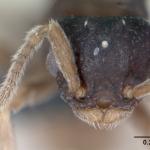Anergates atratulus
Tetramorium atratulum formerly known as Anergates atratulus is an obligate workerless parasite (inquiline) in the colonies of another ant, Tetramorium caespitum. As with many socially parasitic ants, atratulum appear to be related to its host genus and the female morphology is superficially similar. Gynes are about about 2.5mm long, blackish-brown with yellow legs.
The distribution and status of T. atratulum is, not surprisingly, closely linked to that of its host species, which is itself only locally common. T. atratulum has been recorded from the cliffs at Bolt Head and Bolberry Down in S. Devon, the heathlands of Purbeck and around Wareham and Hurn in Dorset, near Burley and Beaulieu Road Station in the New Forest and the heaths at Longmoor in Hants, Pirbright Common in Surrey and the shingle beds around Dungeness. It has also been recorded from Jersey. This parasite is possibly under-recorded. It is present in only a small proportion of host colonies, it is easily overlooked, and the Tetramorium nests are difficult to excavate. T. atratulum is found across the Palaearctic and, along with its host, it has become well established in the eastern United States.
Listed as Rare (RDB3) in Shirt (1987); revised to Insufficiently Known (RDBK) by Falk (1991).
T. atratulum requires a large stable population of its host species to survive. T. caespitum itself is a thermophilous species requiring high levels of insolation at the ground surface. The largest populations of T. caespitum are found in sun-exposed, rocky or shingle coastal sites with short, sparse maritime vegetation. Some lowland heaths also support strong populations of the host but only where the vegetation is short or sparse and there are patches of bare free-draining ground.
Males of T. atratulum are degenerate and wingless, therefore mating occurs within the host nest. The mated gynes then fly out from May to August to find new host colonies.
This is poorly understood but newly mated queens appear to either secure adoption in an old queenless colony of T. caespitum, or they lead to the host queen being killed or starved by her own workers. The parasite seems to predominate in mature T. caespitum colonies where the host workers are notably large and dark. T. atratulum does not have workers of its own and so the entire resources of the host colony are diverted to producing large numbers of new T. atratulum gynes and males. Since no new host workers are generated, T. atratulum queens must produce new generations before the colony dies out in 2-5 years. The queens therefore become massively swollen with eggs (physogastric) and are themselves rarely found in nests. The yellowish larvae (contrasting with the white Tetramorium larvae), and the winged gynes or the pale pupoidal males are more often seen.
T. atratulum has no worker caste, the queen, brood and young sexuals are therefore totally dependent on the host Tetramorium workers for food. T. caespitum workers are predators and scavengers of animal and plant material (notably including seeds).
2021


